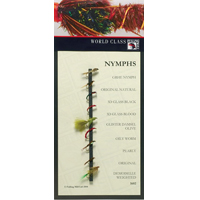
Wild and free, large brown trout are elusive creatures capable of detecting minute changes in their surroundings. Stalking them is difficult, especially as the season comes to a close.
Away from the noise and bank-thumping palaver of the stockie-basher lies a large brown trout – wise and experienced in the ways of man. He will have seen all the lures, flies and unnatural imitations that humans have to offer and rejected them all, choosing the quiet life behind the natural features which provide him his protection.
If this is the trout you are after, then stalking nymphs are the flies for you (see the selection available to buy below). Simplistic in their makeup – the stalking nymph group of flies have one feature in common – they sink fast.
Used in close contact, these nymphs have a reputation for winkling out the biggies, but are only effective in the hands of those who are prepared to do a bit of creeping around the shadowy areas of the water – away from the rowdy casters and fly box snappers.
Using the stalking nymph is easy – getting into position without scaring off the trophy fish isn’t. Large fish choose places such as under the boughs of half-sunken willows, overgrown grass edging, and clumps of sedges. They are also flighty, and the slightest movement which is out of place will cause a flick of a tail and a cloud of sediment.
To find these fish you have think like them, seeking out the safest spots. Creeping on all fours is no good if you are then going to wave your rod around above the water – your movements have to be painstakingly slow so that your rod tip will be mistaken for a twig. Using your rod tip as a catapult, seek to flick your sinking nymph exactly in front of the large trout’s snout, and watch until you see the fish take your fly.
This is an eyes-on method of fishing. Polaroids are a necessity, the more clearly you can see your target, the better.
A slight movement of his head, a quick flash of white on his jaws or the widening of gill plates are all indications that he has sucked it in. It is then that you lift your rod tip the few necessary inches to set the hook, and with gentleness and tremendous care, you may land the fish of a lifetime!
Playing a large fish in a confined space is not an easy task. The mature fish are aware of how a sunken tree stump will aid their escape. Strong tippets of 6lb breaking strength or more are recommended, and a rod which can cope with some stress will help, enabling you to put pressure on the fish, controlling and maneuvering it out into the open water where it can be brought to the net.
Any heavily weighted nymph with a smooth profile will do the job, the weight of the fly being appropriate to the depth of water being fished.
Examples of successful flies are heavily weighted superglue buzzers, anorexic nymphs such as the Anorexic Diawl Bach, and Sawyer’s Pheasant Tail and Grey Goose Nymphs.
As a regular fisherman, you will no doubt have met all these flies in some form or another. Fairly new inventions, super glue buzzers and anorexically tied nymphs have been around in various shapes and sizes for more than a decade. They are commonly used for trout in reservoirs, but are normally incorporated in a long leader or used with a washing line approach.
Their use as stalking flies is less well-broadcast, but they have the potential to eke out super-large fish when combined with patience, skill, and persistence.
The super-smooth slim profile of the super glue buzzer helps it drop through the water – providing little resistance, and therefore making it a perfect fly to get to visible fish which lie between 2 and 3 feet down. If visibility allows, a lead-wound stalking fly gets to the fish faster, but is not liked by all, as it is an exceptionally heavy fly. Natural prey sink more slowly, but the fast drop is sometimes useful when you are dealing with extra-twitchy trout.
The Diawl Bach is one of the most successful flies ever invented. Ranked almost level with the famous and well-proven Sawyer’s Pheasant Tail Nymph, and made of the same material, it accounts for an exceptional number of fish on every water in the UK every year. Tied in an anorexic style, and weighted with additional layers of lead in the dressing, this fly has all the qualifications for the job – and it works too.
More than anything else – stalking big trout requires a calm and a still mind. It requires persistence, and being prepared to be uncomfortable for periods of time while you search out the specimen fish, but when you do succeed, and your quarry comes to the net, all the effort will have been worth it!
 |
Full Mill – Damsel Nymphs Selection – £8.95
– Classic FM Fiery Brown Weighted |






Leave Your Response